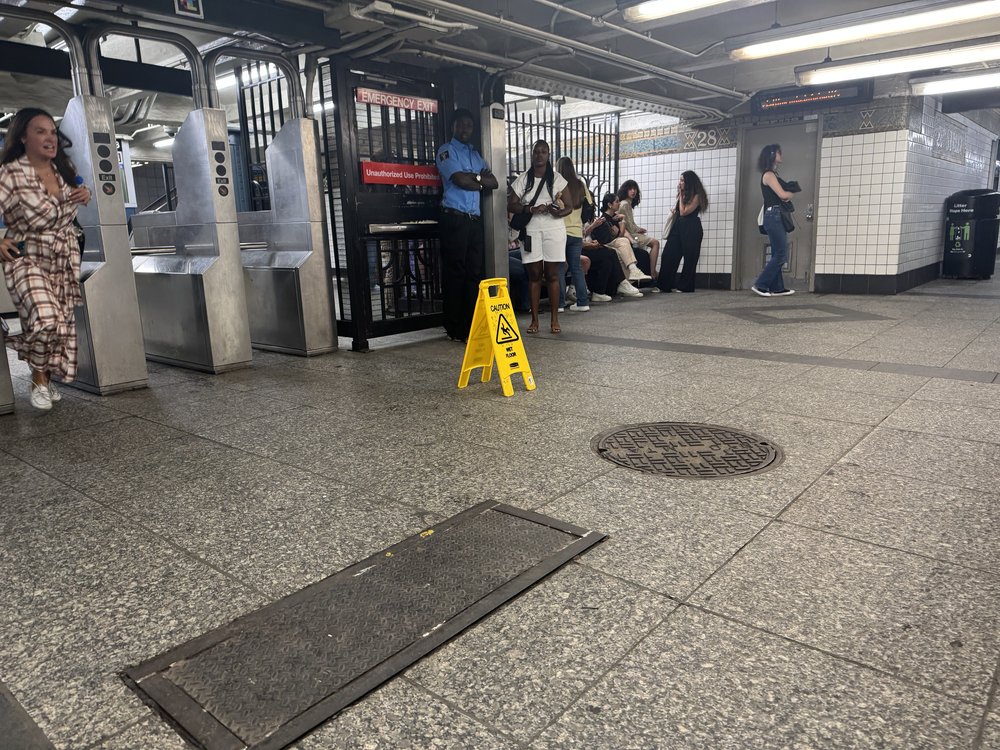It's NYC's own 'Old Faithful.' Chelsea subway station spews again during downpour.
July 15, 2025, 3:05 p.m.
A manhole at the 28th Street station on the 1 line turned into a geyser during Monday night's torrential downpour. It wasn't the first time it happened.

A sewer drain inside Chelsea’s 28th Street subway station spewed water like a geyser during Monday night’s torrential downpour — but it was hardly the first time the location turned into New York City’s version of “Old Faithful.”
Several videos filmed by panicked riders at the 1 line station showed a manhole on the uptown platform spewing a river of water that flooded several train cars. Commuters stood on seats to avoid the deluge, which resembled a scene out of a disaster film.
Videos of severe flooding on the same platform have gone viral several times over the past decade. Each one highlights the fragile state of the city’s outdated sewer infrastructure that’s unable to handle heavy rainstorms, which experts say are growing more frequent due to climate change.
This is at the 28rd Street station on the 1 train right now.@newyorkers_x@newyorkpost
— Juan Luis Landaeta (@Landaeta) July 14, 2025
📸 Juan Luis Landaeta#nyc #NewYork pic.twitter.com/NuVlZkbRIq
“It flooded this way many times before … and now we’re back to square one,” Chelsea resident Homer Carroll said as he stood atop the manhole-turned-fountain on Tuesday. “Maybe that was such a bad storm that there was nothing to be done.”
“I’m not angry, just disappointed,” added Carroll, 70.
According to the National Weather Service, about 2.7 inches of rain poured down on the city in a single hour on Monday. MTA Chair Janno Lieber on Tuesday pointed out the city’s sewer system is only designed to handle 1.75 inches of rain per hour.
“ That's what resulted in those geyser-like conditions that you saw at 28th Street where the city's own stormwater management system, the sewer system, gets backed up and then a manhole gets popped and you see that geyser-like condition,” he said. “We're working with our friends in city government to say, ‘Let's upsize the capacity because this is the era of climate change you’re going to have more of these events.’”
The only other time the city saw more inches of rain in a single hour was during Hurricane Ida in 2021. The manhole on the 28th Street platform also turned into a fountain during that downpour.
A.J. Orlikoff, a tourist from Washington, D.C., visited the station on Tuesday as if it were the Empire State Building or the Statue of Liberty.
"I was like, ‘Yo that’s where it happened!’" Orlikoff said. “We were down a couple stations away and our feet were soaked and it was just ridiculous. It was, like, biblical.”
The storm shut down the 1 train for about two hours and sparked severe delays on the 2 and 3 lines.
MTA officials did not explain why Monday night’s flooding was so much worse at 28th Street than other stations on the 1 line.
The worst of the rainfall hit Upper Manhattan, which has higher ground than the southern end of the borough.
MTA officials have previously noted the subway is capable of handling a tremendous amount of water every day. On a dry day, the system pumps out 10 million gallons of water. On Monday, officials said, it handled 15 million gallons.
Still, the subway’s water pumps are as aging and strained as the city’s sewer system.
The MTA relies on 254 pump rooms to remove water from the subways. Gothamist previously reported several of them run on century-old technology and are unable to handle major rain storms.
The 116th Street pump room on the 2 and 3 lines in Harlem, for example, is “being held together with chewing gum and twine,” the MTA's head of construction Jamie Torres-Springer said last year.
The MTA’s recently approved five-year capital plan allocates $700 million to upgrade more than a dozen subway pump rooms, including the one at 116th Street. An MTA report published last year said all the agency’s facilities, including the commuter railroads, need $6 billion of climate resiliency upgrades over the next decade.
A state of collapse: How the MTA put riders on the fast track to ruin